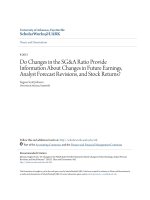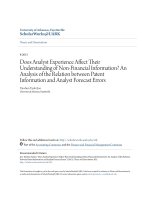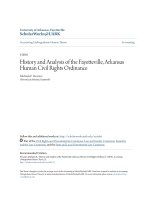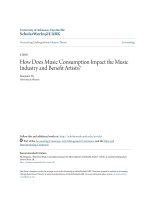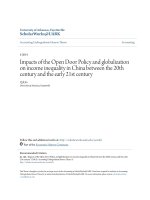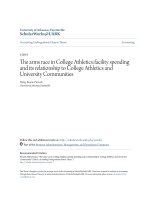Accounting undergraduate honors theses the determinants and consequences of disclosure committee adoption
Bạn đang xem bản rút gọn của tài liệu. Xem và tải ngay bản đầy đủ của tài liệu tại đây (2.05 MB, 105 trang )
University of Arkansas, Fayetteville
ScholarWorks@UARK
Theses and Dissertations
7-2015
The Determinants and Consequences of
Disclosure Committee Adoption
Lyle Roy Schmardebeck
University of Arkansas, Fayetteville
Follow this and additional works at: />Part of the Accounting Commons, Business Administration, Management, and Operations
Commons, and the Corporate Finance Commons
Recommended Citation
Schmardebeck, Lyle Roy, "The Determinants and Consequences of Disclosure Committee Adoption" (2015). Theses and Dissertations.
1188.
/>
This Dissertation is brought to you for free and open access by ScholarWorks@UARK. It has been accepted for inclusion in Theses and Dissertations by
an authorized administrator of ScholarWorks@UARK. For more information, please contact ,
The Determinants and Consequences of Disclosure Committee Adoption
The Determinants and Consequences of Disclosure Committee Adoption
A dissertation submitted in partial fulfillment
of the requirements for the degree of
Doctor of Philosophy in Business Administration
by
Lyle Roy Schmardebeck
Brigham Young University
Bachelor of Science in Accounting, 2009
Brigham Young University
Master of Accountancy, 2009
July 2015
University of Arkansas
This dissertation is approved for recommendation to the Graduate Council.
_________________________________
Dr. Linda A. Myers
Dissertation Director
_________________________________
Dr. Cory A. Cassell
Committee Member
_________________________________
Dr. Kangzhen Xie
Committee Member
_________________________________
Dr. James N. Myers
Committee Member
Abstract
After the passage of the Sarbanes-Oxley Act of 2002, the Securities and Exchange
Commission recommended that companies voluntarily adopt disclosure committees to aid in
preparing company disclosures. In this paper, I investigate the determinants and consequences
of disclosure committee adoption. I find that companies with material weaknesses in internal
controls over financial reporting and less readable 10-K filings are more likely to adopt
disclosure committees. In consequences analyses, using a propensity score matched control
sample and a difference-in-differences research design, I find that 10-K filings are longer and
less readable after disclosure committee adoption. However, consistent with institutional theory,
I do not find evidence of a reduction in information asymmetry or an increase in the
informativeness of earnings following disclosure committee adoption.
Acknowledgments
I am grateful for the guidance and instruction of my dissertation chair, Linda Myers, and
the members of my dissertation committee, Cory Cassell, James Myers, and Kenneth Xie. I also
thank Ben Anderson, T. J. Atwood, Cari Burke, Lauren Cunningham, Andrew Doucet, Taylor
Joo, Stacey Kaden, Gary Peters, Michael Stuart, and seminar participants at the University of
Arkansas, the University of Missouri, and the Miami Rookie Camp for providing helpful
comments and suggestions. I express gratitude to my family for their support and
encouragement. Finally, I express gratitude to my wife, Brenna, because I wouldn’t have been
able to accomplish my goals without her love, friendship, and dedication.
Table of Contents
I.
Introduction ....................................................................................................................1
II.
Background, Prior Literature, and Hypothesis Development ........................................6
A.
Disclosure Committee....................................................................................................6
B.
Annual Report Readability ............................................................................................7
C.
Information Asymmetry.................................................................................................9
D.
Earnings Informativeness.............................................................................................10
III.
Research Design...........................................................................................................12
A.
Determinants of Disclosure Committee Adoption .......................................................12
B.
Propensity Score Matching and Difference in Differences .........................................15
C.
Readability Tests ..........................................................................................................16
D.
Information Asymmetry Tests .....................................................................................18
E.
Earnings Informativeness Tests ...................................................................................20
IV.
Sample Selection and Data ..........................................................................................22
V.
Results ..........................................................................................................................24
A.
Determinants Test and Propensity Score Matching .....................................................24
B.
Readability Tests ..........................................................................................................27
C.
Information Asymmetry Tests .....................................................................................29
D.
Earnings Informativeness Tests ...................................................................................29
VI.
Additional Analyses .....................................................................................................30
A.
Specific Word Types....................................................................................................30
B.
Disclosure Committee Composition Tests...................................................................32
C.
Internal Control over Financial Reporting ...................................................................35
VII.
Robustness Tests ..........................................................................................................36
A.
Timing of Disclosure Committee Adoption ................................................................36
B.
Measurement Window of Bid-Ask Spreads and Market Illiquidity ............................37
C.
Alternative Measure of Information Asymmetry ........................................................37
VIII.
Conclusion ...................................................................................................................38
IX.
References ....................................................................................................................41
X.
Appendix A: Sample Disclosure Committee Charter ..................................................46
XI.
Appendix B: Variable Definitions ...............................................................................48
List of Tables
1. Disclosure Committee Sample Summary ....................................................................52
Panel A: Disclosure Committee and Control Observations by Year ...........................52
Panel B: Disclosure Committee and Control Observations by Fama and French
(1997) Industry.............................................................................................................53
2. Descriptive Statistics for Determinants Model ............................................................55
3. Determinants Model with Fama and French (1997) Industry Classification ...............56
4. Determinants Model with One Digit SIC Codes .........................................................57
5. Propensity Score Matching ..........................................................................................58
Panel A: Sample Selection ...........................................................................................58
Panel B: Covariate Balance .........................................................................................58
6. Difference in Governance Controls .............................................................................59
Panel A: Before Adoption ......................................................................................59
Panel B: After Adoption ........................................................................................59
7. Difference in Differences Sample Selection ................................................................60
Panel A: Readability Tests .....................................................................................60
Panel B: Information Asymmetry Tests ................................................................60
Panel C: Earnings Informativeness Tests ..............................................................60
8. Number of Words Test.................................................................................................61
9. Gross File Size Test .....................................................................................................62
10. Net File Size Test ........................................................................................................63
11. Bid Ask Spread Test ....................................................................................................64
12. Market Illiquidity Test .................................................................................................65
13. ERC Test ......................................................................................................................66
14. FERC Test ...................................................................................................................67
15. Number of Positive Words Test ...................................................................................68
16. Number of Negative Words Test .................................................................................69
17. Number of Neutral Words Test....................................................................................70
18. Percentage of Positive Words Test ..............................................................................71
19. Percentage of Negative Words Test .............................................................................72
20. Percentage of Neutral Words Test ...............................................................................73
21. Disclosure Committee Composition Descriptive Statistics .........................................74
22. Disclosure Committee Composition Number of Words Test ......................................75
23. Disclosure Committee Composition Gross File Size Test ...........................................76
24. Disclosure Committee Composition Net File Size Test ..............................................77
25. Disclosure Committee Composition Percentage of Positive Words Test....................78
26. Disclosure Committee Composition Percentage of Negative Words test ...................79
27. Disclosure Committee Composition Bid-Ask Spread Test .........................................80
28. Disclosure Committee Composition Illiquidity Test ...................................................81
29. Disclosure Committee Composition ERC Test ...........................................................82
30. Disclosure Committee Composition FERC Test .........................................................83
31. Disclosure Committee Adoption and Current Material Weaknesses ..........................84
32. Disclosure Committee Adoption and Future Material Weaknesses ............................85
33. Number of Words Test Excluding Unclear Adoption Timing Observations ..............86
34. Gross File Size Test Excluding Unclear Adoption Timing Observations ...................87
35. Net File Size Test Excluding Unclear Adoption Timing Observations .......................88
36. Bid-Ask Spread Test Excluding Unclear Adoption Timing Observations ..................89
37. Market Illiquidity Test Excluding Unclear Adoption Timing Observations ...............90
38. ERC Test Excluding Unclear Adoption Timing Observations ....................................91
39. FERC Test Excluding Unclear Adoption Timing Observations .................................92
40. Bid-Ask Spread Test Measuring BA_SPREAD over the fiscal year ............................93
41. Market Illiquidity Test Measuring ILLIQUIDITY over the fiscal year........................94
42. Residual Volatility Test ...............................................................................................95
I.
Introduction
In an effort to assist companies in dealing with additional disclosure requirements and
increased scrutiny over financial reporting practices following the adoption of the SarbanesOxley Act of 2002 (SOX), the Securities and Exchange Commission (SEC) recommended that
companies adopt disclosure committees “with the responsibility of determining the materiality of
information and determining disclosure obligations on a timely basis” (SEC 2002; Bevilacqua
2004). Although disclosure committee adoption is voluntary, regulators and practitioners believe
that a disclosure committee is an essential part of a company’s communication process (SEC
2002; Deloitte and Touche 2003; Deloitte 2013).
Disclosure committee responsibilities can include reviewing the design and operation of
disclosure controls, determining whether periodic filings (e.g., 8-K or Form 4 filings) are
necessary, and drafting and reviewing quarterly and annual filings (i.e., 10-Qs and 10-Ks).
Although the composition of disclosure committees is not regulated, most are comprised of
management (e.g., the Chief Executive Officer (CEO), Chief Financial Officer (CFO), Chief
Accounting Officer, General Counsel, and Chief Investor Relations Officer) and board members
(Bocchio and Daly 2007; McCarthy 2008). Most disclosure committees meet at least quarterly
(KPMG 2011a) and report directly to the CEO or CFO (Deloitte 2013; WSJ 2013). Therefore,
committee meetings can require a significant investment of management time and company
resources. Although regulators, practitioners, and the business press highlight the potential
benefits of disclosure committee adoption, to my knowledge, no prior studies examine why
companies form disclosure committees and whether disclosure committee adoption influences
disclosure quality and/or market outcomes.
1
In this study, I examine the determinants and consequences of disclosure committee
adoption. To perform my analyses, I hand collect a sample of disclosure committee adopters by
performing keyword searches of SEC filings on EDGAR. Using a sample of 764 disclosure
committee adoptions, I find that companies are more likely to adopt disclosure committees when
there are prior year material weaknesses in internal controls over financial reporting or when
prior year 10-K filings are less readable. I also find that disclosure committee adoption is more
likely among larger companies and companies engaging a Big N auditor.
Next, I investigate how disclosure committee adoption influences corporate disclosures.
Companies might adopt disclosure committees to facilitate the transfer of information across the
entity or to signal improved disclosure quality and reduce agency costs.1 However, under
institutional theory, corporate governance mechanisms may be “primarily ceremonial and serve
as symbols of effective oversight” (Beasley et al. 2009, p. 69). Thus, disclosure committee
adoption may not have an effect on disclosure quality.
I first examine the impact of adoption on the length and readability of 10-K filings. The
SEC’s Plain English Rule mandates clear language that avoids “boilerplate” disclosure (SEC
1998). More recently, the SEC has undertaken projects to reduce disclosure overload and
improve the effectiveness of disclosures.2 Prior research suggests that shorter and more readable
10-K filings are more informative to investors and analysts (Li 2008; Miller 2010; Lehavy et al.
1
Suggested benefits of disclosure committees include improving disclosure quality by
formalizing the disclosure process and aiding in the accumulation of financial information,
determining the materiality of transactions, and communicating this information to management
in a timely manner (Bocchio and Daly 2007; McCarthy 2008).
2
For example, the SEC is currently working to help companies improve disclosure quality by
suggesting that they remove duplicate, redundant, or unnecessary disclosure from 10-K filings
and by identifying areas where additional disclosure may be useful or necessary (see SEC
Changes Tack on Disclosure Overload Project, available at:
/>2
2011; Loughran and McDonald 2014). If disclosure committee adoption represents a
commitment to improved disclosure quality, then I expect 10-K filings to be shorter and more
readable post-adoption. However, if disclosure committee adoption is primarily ceremonial, then
the length and readability of 10-K filings should be unaffected or 10-K filings should become
longer and less readable post-adoption.
I also examine whether the adoption of a disclosure committee influences the level of
information asymmetry and the informativeness of earnings. Prior research suggests that
increased disclosure quality reduces the likelihood that investors discover and trade on private
information and therefore decreases information asymmetry (Brown and Hillegeist 2007). Thus,
if disclosure committee adoption improves disclosure quality, then I expect that the level of
information asymmetry will decrease post-adoption. However, if disclosure committee adoption
is primarily ceremonial in nature or decreases disclosure quality, then I expect no change or an
increase in information asymmetry after disclosure committee adoption. Prior research also
suggests that more informative disclosure can improve the informativeness of earnings (Healy et
al. 1999) and can increase the amount of future earnings news reflected in current returns
(Lundholm and Myers 2002). If disclosure committee adoption improves disclosure quality,
then I expect the informativeness of earnings to increase post-adoption. However, if disclosure
committees do not change or reduce disclosure quality, then I expect no change or a decrease in
the informativeness of earnings post-adoption.
In my consequences tests, I use a difference-in-differences research design and select a
control sample of companies that did not adopt a disclosure committee using a propensity score
matching method that controls for observable company characteristics (Rosenbaum and Rubin
1983). Specifically, I match each company in the treatment sample (i.e., each of the disclosure
3
committee adopters) with a company that does not adopt a disclosure committee but is as likely
to adopt given its observable characteristics.
I find that companies adopting disclosure committees file longer and less readable 10-Ks
post-adoption. Specifically, I find that disclosure committee adoption is associated with an 8
percent increase in the number of words in the 10-K filing and an 8 percent increase in gross 10K file size, representing an increase in length of 6 pages of single spaced text, on average. Thus,
disclosure committee adoption does not improve the readability of the annual 10-K filing. In
addition, I find no relation between disclosure committee adoption and level of information
asymmetry or between disclosure committee adoption and the informativeness of earnings.
Taken together, these results suggest that disclosure committee adoption is associated with
longer and less readable 10-K filings, but these longer and less readable 10-K filings do not
influence market outcomes.
In additional analyses, I examine the relation between disclosure committee adoption and
specific word types used in the 10-K filing. After disclosure committee adoption, I find an
increase in positive, negative, and neutral words. However, I do not find a change in the
proportions of positive, negative, or neutral words to total words in the 10-K after adoption.
These results suggest disclosure committee adoption is associated with an increase in words in
general and do not change the sentiment or tone of the 10-K filing. Next, I use a subsample of
companies that disclose the composition of their disclosure committee and investigate whether
the composition of the disclosure committee impacts the length and complexity of the 10-K
filing, information asymmetry, and earnings informativeness. In these tests, I find some
evidence that the inclusion of senior management on the disclosure committee is associated with
longer 10-K filings. I do not find robust evidence suggesting that the inclusion of senior
4
management on the disclosure committee influences information asymmetry or the
informativeness of earnings. Last, I examine the relation between disclosure committee adoption
and the quality of internal controls over financial reporting. I find an increase in likelihood of an
internal control weaknesses reported in the year of disclosure committee adoption. However, I
also find a decrease in the likelihood of internal control weaknesses reported in the year after
adoption. Taken together, these results suggest that disclosure committee adoptions are a signal
of an improvement in current and future internal controls over financial reporting.
My findings should be of interest to academic researchers, regulators, investors, and other
stakeholders interested in the determinants and consequences of disclosure committee adoption.
Consistent with institutional theory, my findings suggest that the disclosure committee adoption
is primarily ceremonial in that although it affects the amount of quantity of disclosure, it does not
improve disclosure quality. This suggests that the investment of management time and company
resources may not benefit shareholders. Finally, my finding that disclosure committee adoption
increases the length and decreases the readability of 10-K filings could be problematic given
recent efforts by the SEC to reduce disclosure overload.
The remainder of this paper is organized as follows. In Section 2, I provide background
information about disclosure committees, review prior literature, and develop my hypotheses. In
Section 3, I describe my research design. Section 4 describes my sample selection and data.
Section 5 presents the results of my empirical tests. Section 6 presents additional analyses.
Section 7 describes my robustness tests and Section 8 offers concluding remarks.
5
II.
Background, Prior Literature, and Development of Hypotheses
A.
Disclosure Committees
Disclosure committee adoption represents a significant investment of management time
and company resources. In general, disclosure committees provide guidelines for disclosure and
determine the appropriateness of public disclosures. Specifically, disclosure committees should
ensure that company filings are fair, accurate, timely, and complete by creating, reviewing, and
disseminating financial disclosures made by the company (Deloitte and Touche 2003).3
Typically, one of the primary responsibilities of the disclosure committee is to draft and
review the annual 10-K filing. The 10-K is one of the most important documents filed by a
public company because it contains both summary information related to prior year performance
and forward-looking information that helps investors anticipate future performance.4 Proponents
suggest that disclosure committees can help managers determine what information to disclose in
the 10-K as well as how and when to disclose this information. For example, Tysiac (2012)
suggests that the disclosure committee can help improve reporting in the Management
Discussion & Analysis section of the 10-K by monitoring such items as financial covenants,
regulatory and legislative changes, problems with customers and suppliers, and litigation
developments. Disclosure committees can take the lead in benchmarking key disclosures against
industry peers and advising management on which disclosures to include or exclude from
company filings (McCarthy and Iannaconi 2010). Moreover, disclosure committees can reduce
3
An example of the responsibilities section of a Disclosure Committee Charter appears in
Appendix A. Among the responsibilities listed, Cardinal Health’s Disclosure Committee has
oversight of the preparation of the Company’s 10-K filing.
4
I follow Griffin (2003) and Loughran and McDonald (2014) and focus on annual 10-K filings
rather than 10-K and 10-Q filings because prior research suggests that 10-K filings are more
informative than 10-Q filings to investors.
6
the complexity of financial disclosures made in 10-K filings (KPMG 2011b). Alternatively,
according to an audit committee member of a company listed on the New York Stock Exchange,
disclosure committees place a burden on management and on the audit committee by adding
another layer of bureaucracy to the organization (Tremblay and Gendron 2011).
Companies might adopt disclosure committees to reduce agency costs by providing a
signal of improved disclosure quality. However, the adoption of a disclosure committee might
also be a ceremonial governance choice that doesn’t improve disclosure quality or provide
perceived benefits to shareholders. As such, disclosure committee adoption could be consistent
with institutional theory, which states that some corporate governance structures are merely
symbolic and do not actually improve corporate governance (Scott 1987). In this paper, I
examine whether disclosure committee adoption provides real or perceived benefits to
shareholders by investigating whether disclosure committee adoption influences the readability
of the annual report, information asymmetry, and informativeness of earnings.
B.
Annual Report Readability
Li (2008) was the first to document the effects of complex language in the 10-K filing; he
finds that less readable 10-K filings (i.e., 10-Ks that are less readable) are associated with poor
future performance and lower earnings persistence. You and Zhang (2009) find that investor
underreaction to information in 10-K filings is more pronounced for companies with lengthy 10Ks, and Miller (2010) finds lower overall trading volume for companies with longer and less
readable annual reports.5 In addition, when 10-Ks are less readable, analyst forecast dispersion
and analyst forecast uncertainty are greater and analyst forecasts are less accurate (Lehavy et al.
2011). Moreover, experimental research also finds evidence that the readability of disclosure
5
This lower overall trading volume is driven by less frequent trading by small investors.
7
impacts investors. For example, Rennekamp (2012) finds that investors experience processing
disfluency and rely less on disclosures when readability is poor. Taken together, prior research
suggests that investors and analysts find longer and more complex 10-K disclosures less useful
(Libby and Emett 2014).
Because disclosure committees are often responsible for drafting and reviewing 10-K
filings, I examine the impact of disclosure committee adoption on 10-K disclosure quality. On
the one hand, disclosure committees could improve disclosure quality by helping top
management obtain and summarize information, and draft and review disclosures. Having a
formalized disclosure process and including management from multiple areas within a company
(e.g., legal, investor relations, accounting, and operations) could improve the readability of 10-K
filings. In addition, disclosure committees could improve the readability of 10-K filings by
drafting disclosures that are shorter and more informative. On the other hand, disclosure
committee adoption could lead to longer and less informative 10-K filings because committee
members may increase the length or decrease the readability of 10-Ks because of regulatory or
legal concerns or because committee members may feel obligated to increase disclosure
(regardless of content) given that such a committee has been formed. Because the adoption of a
disclosure committee could increase or decrease the length and/or readability of 10-K filings, my
first null hypothesis is as follows:
H0a: Disclosure committee adoption does not influence the length or readability of a
company’s 10-K filing.
To test this hypothesis, I examine the change in 10-K length and readability following disclosure
committee adoption.
8
Many prior studies use the Fog Index, which measures readability as a function of
average sentence length and the number of complex words, to proxy for readability.6 However,
Loughran and McDonald (2014) find that the Fog Index is misspecified when used to measure
the readability of 10-K filings because many of the “complex words” in the 10-K filing are
simple business terms, rather than words that are difficult to read or understand. Loughran and
McDonald (2014) suggest that the file size of the 10-K filing provides a better measure of
readability because it correlates more strongly than the Fog Index with returns volatility, analyst
forecast error, and analyst forecast dispersion. Thus, I use the 10-K gross file size and net file
size, following Loughran and McDonald (2014), to measure the length and readability of the 10K filing. The 10-K gross file size variable is the size of the 10-K filing as posted on EDGAR
and the net file size variable is the size of the 10-K filing when only textual content is included.
Loughran and McDonald (2014) use both file size measures to proxy for readability. I also
follow You and Zhang (2009) and Miller (2010) and use the number of words in the 10-K filing
as a simple proxy for 10-K length and complexity.
C.
Information Asymmetry
Information asymmetry allows informed investors to benefit by trading based on their
private information. Economic theory suggests that increased disclosure quality reduces
information asymmetry (e.g., between the company and market participants or between informed
and uninformed investors) and many empirical studies provide supporting evidence (Healy et al.
2001; Beyer et al. 2010). In addition, Brown and Hillegeist (2007) suggest that increased
disclosure quality reduces investor incentives for private information search, thereby decreasing
information asymmetry.
6
See, for example, Li (2008) Biddle et al. (2009), Lehavy et al. (2011), and Lawrence (2013).
9
Because disclosure committees are charged with increasing disclosure quality in general
and ensuring that disclosures are complete, accurate, and relevant, changes to disclosures made
by the disclosure committee could reduce information asymmetry by increasing the amount of
information available to investors. However, because disclosure committees could reduce
disclosure or decrease disclosure quality, information asymmetry could increase or be unaffected
by disclosure committee adoption. Stated in the null, my second hypothesis is as follows:
H0b: Disclosure committee adoption does not influence information asymmetry.
To test this hypothesis, I use two common proxies for information asymmetry – bid-ask spreads
and stock illiquidity – and examine the change in information asymmetry after disclosure
committee adoption.
Bid-ask spreads are a common proxy for the level of information asymmetry because
they capture the adverse selection problem that arises from trading in the presence of
asymmetrically informed investors (Healy et al. 1999; Leuz and Verrecchia 2000). Prior
research also uses the level of stock illiquidity to proxy for information asymmetry. This
research suggests that a reduction in information asymmetry resulting from an increase in
disclosure increases the liquidity of a company’s stock (Amihud and Mendelson 1986; Diamond
and Verrecchia 1991). Thus, higher levels of stock illiquidity represents greater information
asymmetry.
D.
Earnings Informativeness
Decades of accounting research investigate the returns-earnings relation (Kothari et al.
2001). This research suggests that current stock returns reflect investor beliefs about current and
future earnings. When investors perceive current earnings to be more informative about
company value, the relation between current stock returns and current earnings surprise (i.e., the
earnings response coefficient (ERC)) will be greater. In addition, stock returns reflect investor
10
beliefs about future performance (Beaver et al. 1980) such that future earnings explain a large
amount of the variation in current stock returns (Collins et al. 1994). Recent literature examines
the impact of disclosure on the relation between current returns and current and future earnings.
This research suggests that companies with large increases in disclosure activity experience an
increase in ERCs (Healy et al. 1999), and that companies with more informative disclosures
experience higher future earnings response coefficients (FERCs) (Gelb and Zarowin 2002;
Lundholm and Myers 2002; Choi et al. 2011).
The SEC and practitioners suggest that disclosure committees should improve the
relevance, timeliness, and credibility of reported performance. Audit firms also suggest that
disclosure committees should help to increase the credibility of reported earnings (PwC 2006).
If disclosure committee adoption improves disclosure quality and the relevance of earnings, then
ERCs will increase following disclosure committee adoption. In addition, if disclosure
committees increase the timeliness and credibility of reported earnings, then FERCs should
increase post-disclosure committee adoption. However, because disclosure committee adoption
may be ceremonial, my third and fourth null hypotheses are as follows:
H0c: Disclosure committee adoption does not affect the market’s response to earnings
news.
H0d: Disclosure committee adoption does not affect the amount of future earnings news
reflected in current returns.
To test this hypothesis, I examine the effect of disclosure committee adoption on both ERCs and
FERCs.
11
III.
Research Design
A.
Determinants of Disclosure Committee Adoption
Examining the consequences of disclosure committee adoption requires controlling for
factors occurring concurrently with the formation of disclosure committees. One way to do this
is to establish a prediction model for disclosure committee adoption and use this to identify a
propensity score matched control sample of companies that do not adopt a disclosure committee.
In developing my prediction model, I acknowledge that some companies may use
disclosure committee adoption to signal improvements in disclosure quality as a means to reduce
agency costs. Therefore, I expect companies with poor quality disclosures in year t-1 to be more
likely to adopt disclosure committees because this can signal to shareholders that they are
making efforts to improve current and future disclosure quality. I also expect larger companies,
higher-growth companies, and companies with more complex operations to be more likely to
adopt disclosure committees because they can assist management in gathering financial
information and drafting and reviewing disclosures. Finally, I include company profitability,
leverage, age, and level of institutional ownership, as well as auditor characteristics in the year
before adoption in my prediction model.7 My prediction model is as follows:
PR(DC_ADOPTt) = α0 + α1 RES_ANNOUNCEit-1 + α2 MWEAKNESS302it-1
+ α3 GROSSFILESIZEit-1 + α4 SIZEit-1 + α5 BTM it-1 + α6 M&Ait-1
+ α7 FINANCINGit-1 + α8 SEGMENTSit-1 + α9 FOREIGNit-1
+ α10 RET_VOLit-1 + α11 STD_SALEit-1 + α12 STD_CFOit-1
+ α13 AR_INit-1 + α14 SPECIAL_ITEMSit-1 + α15 OP_CYCLEit-1 + α16 ROAit-1
+ α17 LEVERAGEit-1 + α18 AGEit-1 + α19 %INST_HOLDit-1 + α20 BIGNit-1
+ α21 AUDITOR_TENUREit-1 + αj INDUSTRYFEit-1 + αk YEARFEit-1 (1)
7
Governance data in machine-readable form is unavailable for half of my sample companies so
include governance variables in my models would result in significant sample attrition.
However, in untabulated analyses, I find no difference in governance characteristics (i.e., audit
committee size, percentage of outsiders on the audit committee, and percentage of outsiders on
the board of directors) between treatment and control companies either before or after disclosure
committee adoption.
12
where:
DC_ADOPTt
= an indicator variable set to one if the company adopted a
disclosure committee during year t, zero otherwise;
RES_ANNOUNCEt-1
= an indicator variable set to one if the company announced
a restatement in year t-1 due to misstatements in prior year
financial statements, zero otherwise (Audit Analytics);
MWEAKNESS302t-1
= an indicator variable set to one if the company disclosed
a material weakness in internal control over financial
reporting under SOX Section 302 in year t-1, zero
otherwise (Audit Analytics);
GROSSFILESIZEt-1
= the natural log of the gross file size of the company’s 10K filing in year t-1 (available from Bill McDonald’s
website)8;
SIZEt-1
= the natural log of total assets in year t-1 (Compustat: AT);
BTMt-1
= book-to-market in year t-1, calculated as the book value
of common equity (Compustat: CEQ) divided by the
market value of equity (Compustat: CHSO x PRCC_F);
M&At-1
= an indicator variable set to one if the company engaged in
a merger or acquisition in year t-1, and zero otherwise
(Compustat: SALE_FN);
FINANCINGt-1
= an indicator variable set to one if M&A is not equal to
one and the number of shares outstanding (Compustat:
CHSO) increased by at least 10 percent during the year, or
if M&A is not equal to one and long-term debt increased by
at least 20 percent during the year, zero otherwise;
SEGMENTSt-1
= the natural log of the number of business segments in
year t-1 (Compustat Segment File);
FOREIGNt-1
= the natural log of the number of foreign segments in year
t-1 (Compustat Segment File);
RET_VOLt-1
= the standard deviation of daily stock returns in year t-1;
8
The 10-K readability data used in Loughran and McDonald (2014) are available at
/>13
STD_SALEt-1
= the standard deviation of sales (Compustat: SALE) for the
prior three years ending in year t-1;
STD_CFOt-1
= the standard deviation of operating cash flows
(Compustat: OANCF) for the prior three years ending in
year t-1;
AR_INt-1
= the proportion of accounts receivable (Compustat: RECT)
and inventory (Compustat: INVT) in total assets
(Compustat: AT) in year t-1;
SPECIAL_ITEMSt-1
= special items (Compustat: SPI) scaled by total assets
(Compustat: AT) in year t-1;
OP_CYCLEt-1
= the company’s operating cycle in year t-1, calculated as
the number of days sales in accounts receivable plus the
number of days sales in inventory;
ROAt-1
= return on assets in year t-1, measured as income before
extraordinary items (Compustat: IB) scaled by total assets
(Compustat: AT);
LEVERAGEt-1
= the debt-to-assets ratio in year t-1 (Compustat: DLTT /
AT);
AGEt-1
= company age in year t-1, calculated as the number of
years during which the company reports total assets on
Compustat (Compustat: AT) greater than zero;
%INST_HOLDt-1
= the percentage of institutional holdings in year t-1
(Thomson Reuters Institutional Holdings);
BIGNt-1
= an indicator variable set to one if the company is audited
by a Big N auditor in year t-1, zero otherwise;
AUDITOR_TENUREt-1
= the length of the company-auditor relationship to date;
FF_INDUSTRYFE
= industry indicator variables defined using the Fama and
French (1997) industry classifications; and
YEARFE
= fiscal year indicator variables.
14
B.
Propensity Score Matching and Difference-in-Differences
Most sample companies disclose the presence of a disclosure committee in their 10-Q,
10-K, or DEF 14A filings. In each instance, I ensure that the disclosure committee was formed
and operating before the fiscal year-end date used to measure my consequences (outcome)
variables. I estimate Equation (1) using the disclosure committee adoption year for my treatment
companies (i.e., I remove the pre-and post-adoption years for companies that adopt a disclosure
committee) and all of the available company-years in the sample period for companies that did
not adopt a disclosure committee.9 I use logit regression with robust standard errors clustered by
company because non-disclosure committee adopters can appear in the sample multiple times. I
use the results from this estimation to propensity score match each treatment company to a
control company in the same year using the caliper method (without replacement). This method
allows me to control for observable company characteristics in my consequences analyses
(Rosenbaum and Rubin 1983). The sets of treatment companies and matched control companies
comprise my sample companies for all remaining analyses.
Because I am interested in the effects of disclosure committee adoption, I use a
difference-in-differences research design. Specifically, my sample includes the year before and
the year after disclosure committee adoption for both treatment companies (i.e., those adopting
disclosure committees) and the propensity score matched control companies (i.e., those not
adopting disclosure committees).10 In all outcome analyses, I also include controls for timevariant characteristics that could influence the outcome variable.
9
I use include all years for the non-disclosure committee adopters because they could have
adopted the committee in any of the years of my sample.
10
The propensity score matched sample also allows me to overcome concerns about violating the
parallel trends assumption that is important for difference-in-differences research designs
(Roberts and Whited 2011).
15

